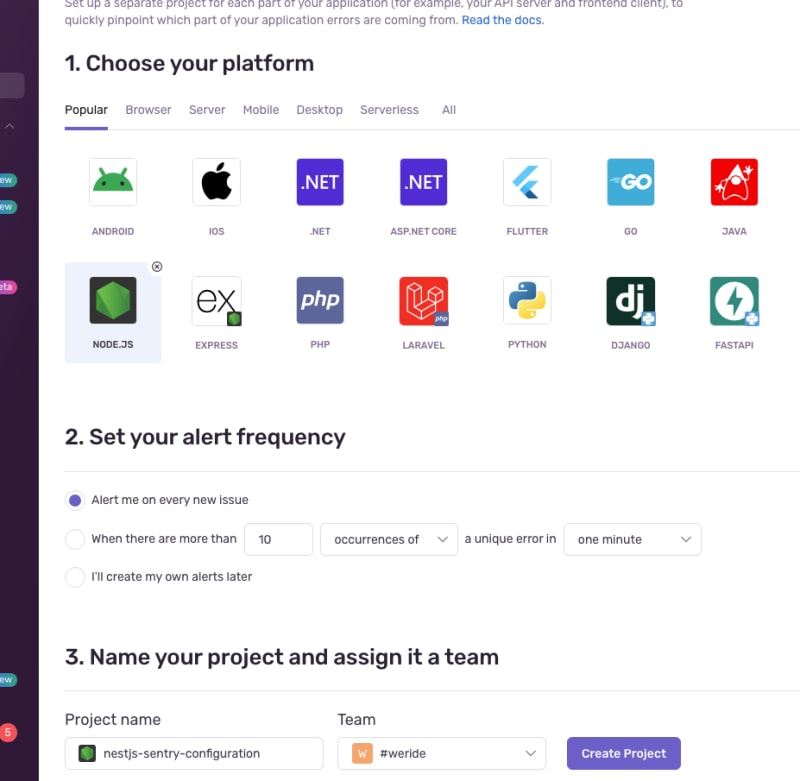Hello fellow coders!
The topic today is extremely important, it is something simple but can be a game change when we are running a service on production and suddenly, the users are having problems, errors, etc.
We are going to have a hands-on example of implementing an error track inside a NestJS project, we are going to use Sentry as a tool to help us see and be ahead of the problem before they are properly reported by the users.
Application Performance Monitoring & Error Tracking Software
Why should I use a tool like that inside my project?
There are many reasons, but the most important one is “to know the error with details in advance before they are reported”.
Imagine that you have lots of microservices or even a large code base, many times a difficult large codebase, and eventually, bugs happen! Some bugs, sometimes require the context or the parameters to be able to simulate. Sometimes you have so many errors that you don’t know which one is the priority, or in which frequency they happen. So many different cases right? That’s why I always put a tool like that into my projects.
Other options
You can find easily many tools that do almost the same as Sentry, some are cool, some are easy to set up, some don’t have a nice view or require more of you to set up… I always choose Sentry or New Relic, but mostly Sentry because they solve my problems very well.
Other options are
Datadog
New Relic
Elastic Observability
Dynatrace
AppDynamics
Setting the project up
For those who never read my articles, I am going to follow the basic setup from this post
Implementing auth flow as fast as possible using NestJS
Because I want to run this project with SWC and the correct tsconfig configuration. Don’t worry, you can find the whole codebase at the end of this post as well.
nest g application nestjs-sentry-configuration
Sentry account
Visit the website https://sentry.io/ and create your account.
Then, let’s create a new project and select Node.JS
Install the dependencies and copy the DSN value.
npm install --save @sentry/node @sentry/profiling-node
Now let’s go back to the NestJS project.
Creating an ExceptionFilter
I am going to create an Exception called sentry.filter.ts. If you want to learn more about Exceptions and how they are handling inside the NestJS, check out this link
Documentation | NestJS - A progressive Node.js framework
My exception file will be like this
import { Catch, ArgumentsHost } from '@nestjs/common';
import { BaseExceptionFilter } from '@nestjs/core';
import * as Sentry from '@sentry/node';
@Catch()
export class SentryFilter extends BaseExceptionFilter {
catch(exception: unknown, host: ArgumentsHost) {
Sentry.captureException(exception);
super.catch(exception, host);
}
}
This is an ordinary exception and we are also extending the BaseExceptionFilter, because I want to keep the original Exception response as soon as the error is tracked. I was doing it when I called.
super.catch(exception, host);
Is important to notice that our @Catch() is empty, it will make that this Exception handles every exception that can happen.
Adding an exception to the global scope
We need to add the Custom exception to the project, and we can do that by editing the main.ts
import { HttpAdapterHost, NestFactory } from '@nestjs/core';
import * as Sentry from '@sentry/node';
import { SentryFilter } from './sentry.filter';
import { AppModule } from './app.module';
async function bootstrap() {
Sentry.init({
dsn: process.env.SENTRY_DNS,
});
const app = await NestFactory.create(AppModule);
const { httpAdapter } = app.get(HttpAdapterHost);
app.useGlobalFilters(new SentryFilter(httpAdapter));
await app.listen(3000);
}
bootstrap();
Please, don’t forget to put the SENTRY_DNS value! Otherwise, it won't work as we want.
And we are done!!
Testing the changes
First, let’s start the project
npm run start:dev
A simple example can be an error like
import { Injectable } from '@nestjs/common';
@Injectable()
export class AppService {
getHello(): string {
throw new Error('Ops, theres a problem!');
return 'Hello World!';
}
}
I am forcing an error, and after requesting the route of this method, I got this report
Here you can find for example:
User
Context
How many times this issue happens
When
Plus (optional)
If you want to implement it as a module and use dependency injecting etc to get more from the errors, and also to have it global, you can do it using the example below as a starting point.
“Binding interceptiors” https://docs.nestjs.com/interceptors#binding-interceptors
import { Module } from '@nestjs/common';
import { APP_INTERCEPTOR } from '@nestjs/core';
@Module({
providers: [
{
provide: APP_INTERCEPTOR,
useClass: LoggingInterceptor,
},
],
})
export class AppModule {}
More examples of using different approaches
Sentry Integration With NestJS
https://github.com/ericjeker/nestjs-sentry-example
Conclusion
It’s been easy to add Sentry or any other Error tracker, and knowing how important it is for any project, I would suggest you add it right now 😄










Top comments (0)